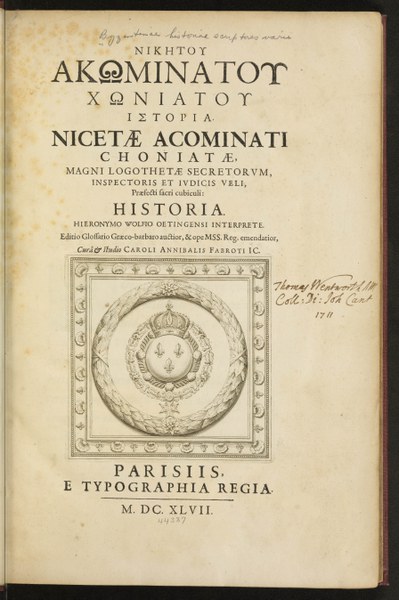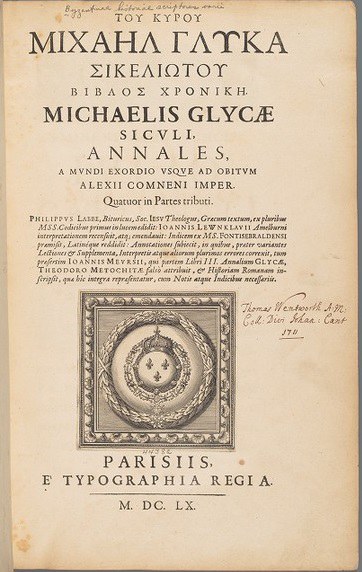
Early Printed Byzantine Texts
The printing of Greek texts in fifteenth-century Europe was fueled by a renewed interest in the classical past and facilitated by the presence of Greek scholars, such as Manuel Chrysoloras, in Italy. The Ottoman conquest of Constantinople in 1453 led to a greater exodus of Byzantine intellectuals, who brought with them manuscripts and language expertise. While the first book printed entirely in Greek was produced in 1476, these early publications focused on grammar—as represented by the works by Theodore of Gaza (Basel 1541) and Manuel Chrysoloras (Venice 1541)—and ancient sources. Byzantine texts such as the Suda and the Planudean Anthology were valued chiefly for the knowledge they provided about antiquity. As it was the content that mattered most, in many cases Latin translations were published long before the Greek originals. Among such early Latin editions are Pseudo-Methodius’ Apocalypse (Augsburg 1496), Eusebius’ Episcopi Chronicon (Henri Estienne, Paris 1512), Procopius’s Ensis de rebus gothorum, persarum ac van dalorum libri VII (Basel 1531), Michael Glycas’ Biblos chronikē (ed. Leunclavius, Basel 1572), and Manuel Palaiologos’ Praecepta educationis regiae (ed. Leunclavius, Basel 1578). Italian translations also appeared relatively early, as demonstrated by Procopius’ De aedificiis (Venice 1547) and the histories by Zonaras and Choniates (Venice 1560; Venice 1562).
In the early sixteenth century, Basel became an important printing center for Greek texts. The Protestant Reformation led the German-speaking humanists to give attention to the early church fathers and church historians, while the Ottoman threat stimulated interest in the rise and fall of the Byzantine empire. Some important early editions of Byzantine historians were produced in Augsburg, residence of the powerful Fugger and Welser banking and merchant families that had business interests in the east. A significant work of early modern scholarship was an edition of the Annals of Zonaras (Basel 1557) commissioned by Anton Fugger and edited by Hieronymus Wolf, described as the “father of German Byzantine studies.” David Hoeschel, a pupil of Wolf, produced the first edition of Photios’ Bibliothēkē (Augsburg 1601). Leiden was another important center for editing Byzantine texts, including Theodor van der Doess edition of the abbreviated version of George Akropolites’ Chronicon Constantinopolitanum (1614).
In the mid-seventeenth century, the Jesuit Philippe Labbe initiated publication of the Paris Corpus, or Byzantine du Louvre, a series of editions of Byzantine historians, with the first volume appearing in 1645. Following the death of Labbe in 1667 and after a hiatus of fifteen years, Charles Du Cange provided a renewed impetus for the project. Some thirty titles were published in luxurious folio volumes, of which Dumbarton Oaks holds most, with the last title published in 1702. In the nineteenth century, a new attempt was made to produce a corpus of Byzantine historiography. Known as the Bonn Corpus (Corpus Scriptorum Historiae Byzantinae), it was initiated by Barthold Georg Niebuhr and, comprising fifty volumes, published between 1828 and 1897.
Searching for Materials in HOLLIS
In addition to select digitized titles, the Dumbarton Oaks Rare Book Collection holds numerous materials related to early printed Byzantine texts. To quickly locate items in HOLLIS, use the “Advanced Search” feature to specify material subject, language, date range, or other criteria. Relevant subjects include the following:
Chronology, Historical -- Early works to 1800

